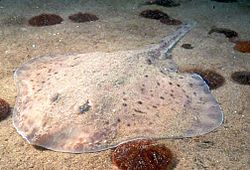Rajiformes
| Rajiformes Temporal range: middle Eocene–Recent |
|
|---|---|
 |
|
| Little skate (Leucoraja erinacea) | |
| Scientific classification | |
| Kingdom: | Animalia |
| Phylum: | Chordata |
| Class: | Chondrichthyes |
| Subclass: | Elasmobranchii |
| Superorder: | Batoidea |
| Order: |
Rajiformes L. S. Berg, 1940 |
Rajiformes is one of the four orders in the superorder Batoidea, flattened cartilaginous fishes related to sharks. Rajiforms are distinguished by the presence of greatly enlarged pectoral fins, which reach as far forward as the sides of the head, with a generally flattened body. The undulatory pectoral fin motion diagnostic to this taxon is known as rajiform locomotion. The eyes and spiracles are located on the upper surface of the head and the gill slits are on the underside of the body. Most species give birth to live young, although some lay eggs with a horny capsule ("mermaid's purse").
Rajoids typically have a dorsoventrally flattened body. The snout is slender and pointed and the wide mouth, often covered with a fleshy nasal flap, is on the underside of the head. The eyes and well-developed spiracles are located on the top of the head. In most species, the spiracles are large and are the main means of drawing water in for respiration. There is no nictitating membrane and the cornea is continuous with the skin surrounding the eyes. The gill slits are on the ventral surface just behind the head and there are five in all species except the sixgill stingray (Hexatrygon bickelli). The front few vertebrae are fused into a synarcual and this either articulates with the bones of the well-developed pectoral girdle or is fused to them, the suprascapulae uniting above the vertebral column. Most species have enlarged, thorn-like dermal denticles on their skin, often with a row of large denticles along the spine.
The pectoral fins are large, but not clearly demarcated from the body, and together with the body are known as the disc. They start from the side of the head in front of the gill openings and end at the caudal peduncle. There are up to two dorsal fins but no anal fin. A slender tail is clearly demarcated from the disc. The caudal fin varies in size between species and the rays have a whip-like tail with no caudal fin.
Species of the order Rajiformes are found throughout the world's oceans, from Arctic to Antarctic waters, and from shallow coastal shelves to open seas and abyssal regions. A few are found in rivers and some in estuaries, but most are marine, living near the sea bed at depths down to 3,000 m (9,800 ft) or more.
...
Wikipedia
